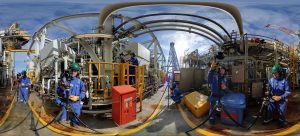
This month, I wanted to take a slightly different approach to our column and share my thoughts and highlight trends relating to one area of concern that is continually reiterated to me in my day to day role, here at Return To Scene.
As an industry, we are continuing our drive towards leaner and more efficient ways of working but despite this, data, a vital commodity for all aspects of oil and gas, is being siloed, and not being used to its maximum advantage, reused or shared to the benefit of the wider business of operators globally.
For over a decade, Return To Scene has conducted top-to-bottom surveys of offshore oil and gas assets from the top of flare tips to the bottom of pontoons on the very largest FPSOs (production ships) to the smallest NUIs (normally unmanned installations).
During that time, we’ve worked with all the supermajors and many of the national oil companies in locations all around the world.
We feel we’ve provided a very valuable service – making our client’s assets more accessible and more understandable to a much wider set of players.
And, because we’ve worked across so many assets and for so many operators, we’ve begun to see trends; trends that need fixing.
So what have we learned in all that time?
We’ve learned that changing out tier-one contractors can leave gaping holes in operator datasets that can never be filled … even by spending additional money.
The nature of contracts often means that only ‘end product data’ … inspection reports, new modules, engineering works, etc, is transferred.
The highly valuable data captured during the often long process of undertaking the work is held by the contractor because it wasn’t specifically requested as part of the deliverable, or the, methods or means to make sense of it are lacking.
What’s the answer? Contract for transparency and methodically collect data on your asset throughout its life. Asset data is like gold. He who has the gold, wins.
We’ve learned that asset transfers can challenge even the most organised. Many operators have been left scratching their heads to find key operational data in the piles of information shovelled from one organisation to the next while an asset changes hands.
‘Unplugging’ an asset from the systems and processes of one and ‘plugging into’ the systems and processes of another is challenging at the best of times. Information is lost because, as a general rule, the resources are not in place to undertake this process, even though it happens regularly.
We’ve see this compounded by organisations building their own bespoke systems to manage the assets rather than using the best the market has to offer.
Alternatively, we see operators buying into ‘top to bottom’ solutions provided by major contractors, even though this leads to ‘system intractability’, effectively stifling innovation, the ability to try new things and falling into the trap of habitual ways of working.
What’s the answer? Plan for change and become a modular organisation with the ability to plug and play. Expect change to happen and you’ll be better able to manage it when it does.
We’ve learned that the same work is often completed again and again on the same asset for different reasons, but paid for each and every time by the operator. In our world – surveying, asset management, and system integration – we see parties on assets working independently but who would benefit from collaboration.
And we’re not talking about grandiose ‘supply chain collaboration’, but instead simply ensuring that, for example, the turnaround (TAR) team gets to use the operations teams’ data on the same asset.
Why would the operations team pay for a total station survey of an asset, lay out an asset-wide coordinate system, and get engineering works completed and then not give that data to the TAR team who need this same information but for different reasons?
The answer is…there is no good reason.
It doesn’t happen because the underlying work of the total station survey is not the deliverable. The engineering work is the deliverable. What’s the answer? As a part of your contracting strategy and execution, map the value of the items that are generated as a part of the entire contract duration and ensure those elements are dutifully handed over from the contractor, ready for re-use. Adopt the mantra “buy once, use often.”
So what does it all mean?
It means that operators have a significant opportunity to glean value from processes they already undertake.
Why undertake 60 surveys on your asset over two years (yes, we’ve seen this)?
Why not conduct one top-to-bottom survey and make that data available to all your internal and external teams, allowing them to update that survey as they undertake periodic work, but always making that new data available to all?
Why contract just for the end deliverable when the process of creating that deliverable generates so much other value? Why not alter the terms of the contract to ensure all elements of value flow from contractor to operator? Why build bespoke systems as-and-when?
With continued downward pressure on the oil price, we’re still in a period of identifying and gleaning value from the hidden corners of our industry.
That is good. That means we’re turning the aircraft carrier more and more each day. When the price rises again, hopefully it will be difficult to turn the aircraft carrier back….and we’ll all be more efficient, leaner and profitable as a result.
Sean Huff is the operations director of Return To Scene Ltd and, as a form Navy man, knows how difficult it is to shift an aircraft carrier. www.r2smosaic.co.uk
Recommended for you

